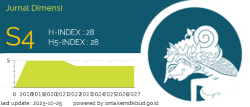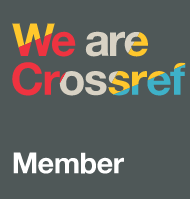Analisis pengaruh Strategi Pemasaran terhadap Kinerja Usaha melalui Kemampuan Pemasaran pada UMKM Tenun di Kota Bima: Pendekatan Technology Acceptance Model (TAM)
Abstract
This study aims to analyze the influence of Marketing Strategy on Business Performance through Marketing Capability in Weaving SMEs in Bima City: A Technology Acceptance Model (TAM) Approach. Amid the significant potential of weaving SMEs in both local and global markets, challenges in the adoption of digital technology remain a major obstacle. This research adopts a quantitative approach using a survey method involving 100 weaving SME actors selected through purposive sampling. Data analysis was conducted using the Partial Least Squares - Structural Equation Modeling (PLS-SEM) method. The results indicate that marketing strategy has a significant effect on both marketing capability and business performance. Furthermore, marketing capability is proven to mediate and strengthen the relationship between marketing strategy and business performance. These findings underscore the importance of enhancing digital-based marketing capabilities as a fundamental pillar in improving the performance and competitiveness of weaving SMEs in the digital transformation era. The practical implications of this study encourage synergy among business actors, government, and supporting institutions to accelerate inclusive and sustainable digital technology adoption in the SME sector based on local wisdom.
Keywords
Full Text:
PDFReferences
Albrecht, C., & McMullen, S. (2019). Business Performance and Measurement in the Digital Era. Oxford Press.
Bagozzi, R. P., & Lee, K. H. (2002). Toward a theory of the emotions in consumer behavior. Psychology & Marketing, 19(12), 1059–1074. https://doi.org/10.1002/mar.10045
Cheng, M., Lee, S. H., & Zhao, L. (2018). The effect of marketing capabilities on the performance of small and medium enterprises (SMEs): A comparison of the manufacturing and service sectors in Taiwan. Journal of Business Research, 90, 319–326. https://doi.org/10.1016/j.jbusres.2018.06.022
Davis, F. D. (1989). Perceived usefulness, perceived ease of use, and user acceptance of information technology. MIS Quarterly, 13(3), 319–340. https://doi.org/10.2307/249008
Ghozali, I., & Latan, H. (2015). Partial Least Squares: Konsep, teknik dan aplikasi menggunakan program SmartPLS 3.0 untuk penelitian empiris. Badan Penerbit Universitas Diponegoro.
Ghozali, I. (2017). Aplikasi analisis multivariate dengan program IBM SPSS 25 (9th ed.). Badan Penerbit Universitas Diponegoro.
Hair, J. F., Hult, G. T. M., Ringle, C. M., & Sarstedt, M. (2014). A primer on partial least squares structural equation modeling (PLS-SEM). SAGE Publications.
Hair, J. F., Black, W. C., Babin, B. J., & Anderson, R. E. (2010). Multivariate data analysis: A global perspective (7th ed.). Pearson Education.
Kaplan, R. S., & Norton, D. P. (1996). The Balanced Scorecard: Translating strategy into action. Harvard Business Press.
Kotler, P., & Armstrong, G. (2016). Principles of marketing (16th ed.). Pearson Education.
Kotler, P., & Keller, K. L. (2016). Marketing management (15th ed.). Pearson Education.
Miftah, S., Hidayati, N., & Atmadja, I. W. (2020). The role of social support in small and medium enterprises (SMEs) technology adoption. Journal of Small Business Management, 58(3), 545–567. https://doi.org/10.1111/jsbm.12311
Morgan, N. A., Vorhies, D. W., & Mason, C. H. (2009). Market orientation, marketing capabilities, and firm performance. Strategic Management Journal, 30(8), 909–920. https://doi.org/10.1002/smj.764
Pereira, V. G., Lima, L. G., & Lima, F. F. (2019). The impact of digital marketing strategies on SMEs' performance: Evidence from Brazil. International Journal of Market Research, 61(4), 434–449. https://doi.org/10.1177/1470785319848015
Santos, V., Ferreira, J. J., & Jalali, M. S. (2017). The influence of innovation capacity on business performance: Evidence from Portuguese SMEs. European Journal of Innovation Management, 20(4), 580–600. https://doi.org/10.1108/EJIM-12-2016-0118
Sharma, R., Sharma, M., & Joshi, S. (2018). Examining the role of perceived value and technology acceptance model in online grocery retailing. International Journal of Retail & Distribution Management, 46(10), 1025–1037. https://doi.org/10.1108/IJRDM-09-2017-0196
Situmorang, A., & Ginting, M. (2019). Penerapan strategi pemasaran digital terhadap peningkatan daya saing UMKM. Jurnal Ekonomi dan Bisnis, 22(2), 85–98.
Syah, Y. S. (2020). Strategi pemasaran digital pada UMKM berbasis teknologi. Jurnal Ilmu Ekonomi dan Bisnis Islam, 5(1), 45–57.
Tambunan, T. (2019). Usaha Mikro Kecil dan Menengah di Indonesia: Isu, perkembangan dan kebijakan. LP3ES.
Teece, D. J., Pisano, G., & Shuen, A. (1997). Dynamic capabilities and strategic management. Strategic Management Journal, 18(7), 509–533. https://doi.org/10.1002/(SICI)1097-0266(199708)18:7<509::AID-SMJ882>3.0.CO;2-Z
Venkatesh, V., & Davis, F. D. (2000). A theoretical extension of the Technology Acceptance Model: Four longitudinal field studies. Management Science, 46(2), 186–204. https://doi.org/10.1287/mnsc.46.2.186.11926
Widyastuti, U., Susanti, A., & Rachmawati, S. (2017). Kemampuan pemasaran digital dalam peningkatan kinerja UMKM. Jurnal Ilmu Ekonomi, 11(1), 20–34.
DOI: https://doi.org/10.33373/dms.v14i2.7780
Refbacks
- There are currently no refbacks.

This work is licensed under a Creative Commons Attribution 4.0 International License.











